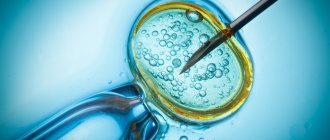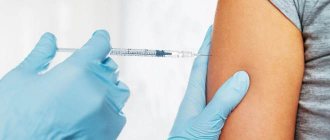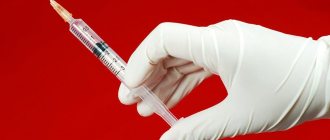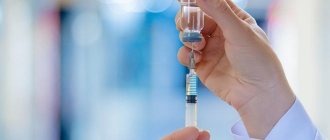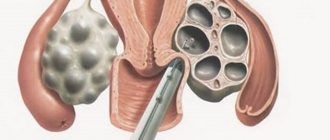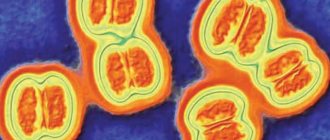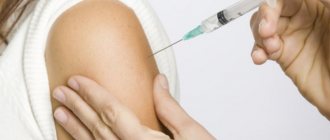Many patients are concerned about the answer to the question: “The hCG 5000 injection was performed, how long after ovulation?” To understand the principle of action of human chorionic gonadotropin, you need to carefully understand its properties.
This hormone is indispensable if a woman plans to conceive and carry a child. However, there are situations when not enough of it is produced naturally, and it is because of this that pregnancy is impossible. In such a situation, a doctor may prescribe an injection of a synthetic analogue of this hormone.
Ovulation formula
Knowing when ovulation occurs is important for resolving two issues: if a woman wants to get pregnant or if a woman chooses a calendar method of birth control. The fertile period—the period when fertilization can occur—lasts approximately six days: five days before ovulation and the day of ovulation. The highest probability of conception is within two days before and on the day of ovulation.
Calculating the day of ovulation mathematically makes sense if you have a very clear and stable menstrual cycle. The length of the first phase of the cycle varies. The second phase is more stable and lasts 14 days. Accordingly, to calculate the day of ovulation, you need to subtract 14 from the cycle length. In an ideal 28-day cycle, ovulation occurs exactly in the middle: 28-14 = 14. In a short cycle it will occur earlier: for example, with a cycle length of 24 days, ovulation will occur approximately on the 10th day. In the long one - later: 33-14 = 19. For women whose menstrual cycle fluctuates by several days, the formula becomes more complicated: you need to take into account the duration of both the shortest and longest cycle, and calculate the average. Still, the figure will only be approximate.
A woman can determine days favorable for conception if she pays attention to the changes that occur to her on certain days of the cycle. These changes are most noticeable in the lining of the uterus and cervix.
Complications
Any introduction of a hormonal drug disrupts the natural processes in the body. As a result of an incorrectly selected concentration, the patient may experience complications - a cyst, fluid accumulation, thrombosis, hyperstimulation, accompanied by shortness of breath, abdominal pain, and strong heartbeat.
Some patients may experience nausea, vomiting, or depression after administration of hCG. As soon as the treatment is over, the unpleasant symptoms will disappear.
An injection of the hCG hormone is necessary to stimulate ovulation and further support pregnancy. This treatment is prescribed to patients who do not have enough natural hormones or have certain pathologies in the functioning of the ovaries.
The physician individually selects the appropriate course of therapy and dosage of the drug for each patient.
Pregnancy should occur in the first few cycles after the injection. Share:
Slime
The glands of the cervix produce mucus. It is usually thick: a real plug that closes the cervical canal and prevents infections from passing into the uterus. In such thick mucus, sperm quickly lose mobility and it is difficult for them to ascend into the uterine cavity. But the main (dominant) follicle growing in the ovary, from which the egg will be released, produces the hormone estradiol. The more estradiol, the more cervical mucus becomes and the thinner it is. On the eve of ovulation, it becomes stretchable, like egg white. For some women, this sticky clear discharge in the middle of the cycle is very noticeable. For some - a few days before ovulation, for others - only on the day of ovulation itself. It's individual.
Pain
Ovulation may be indicated by pain in the lower abdomen on days of the cycle that are not associated with menstrual bleeding. The pain can be in the lower abdomen in the center or on the right/left - depending on which ovary the dominant follicle matures in. The pain is often nagging in nature. It may be accompanied by slight bloating or a feeling of fullness in the lower abdomen. At first the pain is minor, but over the course of a couple of days it may intensify. These pains are associated with an increase in the level of biologically active substances in a woman’s body before ovulation - prostaglandins. Prostaglandins dissolve the follicle wall and ovarian tissue so that the egg can be released into the abdominal cavity, and from there enter the fallopian tube. A “side effect” of prostaglandins is pain. Just like a change in the nature of cervical mucus, pain associated with ovulation can occur only on the day of ovulation itself or be noted on the eve of ovulation and even a day or two after it.
Indications for injection
Ask your gynecologist when ovulation occurs after an hCG injection. Here, a lot depends on the amount of active substance and the individual characteristics of the expectant mother’s body.
HCG injections for ovulation are made from a protein structure contained in the urine of a woman carrying a baby. The substance can activate the natural production of sex hormones. HCG for injection can have different medical names - Menogon, Novarel, etc. The doctor performs an injection with a special insulin syringe into the groin area. The main indications for such a procedure can be considered:
- Pathologies accompanied by ovarian dysfunction.
- Painful periods, clear signs of PMS.
- Infertility is associated with the lack of release of an egg or the formation of a dominant follicle.
- Suppression of the corpus luteum.
- Frequent cases of spontaneous abortion.
- Stimulation of the formation of an active egg during preparation for the IVF protocol.
How to understand that pain is associated with ovulation
It is important to understand that pain in the lower abdomen can be associated with much less pleasant reasons than ovulation.
How to understand that this is exactly “it”.
- The pain lasts 1-3 days and goes away on its own.
- The pain is repeated in several cycles.
- About 14 days after such pain, the next menstruation comes.
Pain during ovulation is moderate and does not require painkillers. Severe pain indicates a health problem. If the pain is severe on the days of expected ovulation, you should consult a gynecologist. Other alarming symptoms that accompany pain in the lower abdomen and which may indicate a problem with the uterus and appendages: increased body temperature, increased discharge (leucorrhoea) from the genital tract, change in color of leucorrhoea from transparent or white to yellow-green, bloody discharge. By the way, taking painkillers and NSAIDs (non-steroidal anti-inflammatory drugs) on the days of expected ovulation or shortly before ovulation can reduce the chances of conception.
Why can your head, chest, or ovaries hurt when stimulated?
Taking hormonal drugs affects the synthesis of vasoactive substances. They dilate blood vessels, increasing the distance between cells. As a result, fluid flows more easily into the extravascular space. This leads to changes in the general condition against the background of stimulation performed within the framework of IVF protocols.
Dilation of blood vessels in the brain causes headaches. The release of fluid into the intercellular space in the mammary glands leads to compression of the nerve endings and the appearance of chest pain. The ovaries may hurt slightly even normally, that is, when there is no hyperstimulation syndrome. This is due to a hormone-mediated increase in blood flow in these organs. They increase in volume and compress the nerve endings. Such symptoms usually do not cause significant discomfort to the woman, so they do not require pharmacological correction.
Home test
Ovulation can be determined using a home test, which is sold at the pharmacy. The principle of the study is based on determining the concentration of luteinizing hormone (LH) in the urine. LH levels in women fluctuate depending on the period of the menstrual cycle. Immediately before ovulation it reaches its maximum values. An ovulation test makes it possible to register the peak of LH release into the blood. After the maximum LH surge, ovulation occurs within the next 36 hours. Therefore, with a positive ovulation test, this and the next day are the most favorable for conception.
All about ovulation. Most Frequently Asked Questions
1. Is it rare for a healthy woman to have several eggs mature at the same time?
The maturation of eggs is a complex process that depends on the hormonal activity of the body. It is known that the maturation of most embryonic germ cells occurs in utero. Starting from adolescence, under the influence of pituitary hormones, cyclic changes occur in the ovaries. The fate of each follicle is under the control of endocrine systems, from which subsequent events occur - follicle growth, choice of a dominant (leading), egg maturation, ovulation and formation of the corpus luteum. As a rule, people mature 1 egg per cycle. The maturation of multiple eggs is rare for women. Most often, this can happen to couples who have had twins in their family. Also, the maturation of several eggs occurs in ART (assisted reproductive technology) programs. During the programs, several eggs are grown and fertilized.
2. How does a woman’s age affect ovulation? Is it normal to have a cycle without ovulation?
A woman’s age is an indisputable argument in assessing the functional state of a woman’s reproductive system. To date, the basic patterns of the processes of follicle growth, ovulation and development of the corpus luteum have been determined, and they are associated, in particular, with the hormonal regulation of the body. With age, the number of follicles in a woman’s ovary decreases and the quality of the eggs changes. The process of “aging of the ovaries” begins at the age of 30 and after 37 years the number of follicles from which eggs mature sharply decreases. Although within the limits of age, especially the older reproductive age, there are individual characteristics determined by human genetics. However, the age at which the ability to conceive is lost and the age at which the ovaries lose hormonal function, as a rule, do not coincide. At the age of 40 to 45 years, a woman loses the ability to conceive, since few cycles with ovulation occur, but she may continue to have menstrual cycles and hormonal activity of the ovaries for another 10 years.
Anovulatory cycles are considered a variant of the norm during the year when menstrual function develops in adolescents and when taking contraceptives. There may be no ovulation for a short time due to stress or illness. Anovulatory cycles are also possible in healthy women (1-2 times a year). The constant absence of ovulation during reproductive age is not the norm and requires consultation, examination, and treatment by a doctor, since it indicates a disease and the development of infertility in a woman.
3. What diseases interfere with egg maturation?
There are several groups of diseases that disrupt the maturation of the egg. Often several diseases are detected simultaneously that affect ovulation and lead to infertility in a woman.
1. The psychological state of the woman (chronic stress).
2. Mental illness.
3. Genetic diseases.
4. Benign and malignant tumors of various organs and systems.
5. Diseases of organs such as the pituitary gland, thyroid gland, adrenal glands, pancreas, mammary glands, ovaries, which can cause changes in hormonal status
6. Inflammatory diseases, especially of the reproductive organs.
7. Obesity and other metabolic disorders.
4. Measuring basal temperature - an indicative method? Can ovulation occur at temperatures below 37*. Can the temperature rise and ovulation not occur?
Measuring basal body temperature (BT) is a functional diagnostic test that allows you to assess the hormonal function of the body and indirectly determine the fertile phase of the menstrual cycle. Temperature is influenced by many factors in a woman’s physical and psychological state: sleep disturbance, illness, stress, sexual intercourse. In this regard, changing BT is not the main, but an auxiliary method for determining ovulation in a woman and the state of her hormonal levels. The measurement results are entered into a special chart. In the first half of the cycle it is below 37*, the day before ovulation the temperature drops, and during ovulation it rises by 0.3 - 0.6* and remains at this level until the end of the cycle, at least 12 days (within 37.0 - 37.4*). 2-3 days before the start of menstruation, BT begins to decrease, reaching approximately 37* at the beginning of menstruation. The difference between the first phase and the second phase must be at least 0.4 – 0.5*. An ideal schedule is quite rare. BT variants can be varied, with each feature indicating certain disorders. As a rule, the difference between the average BT value of phases 1 and 2 is less than 0.4* - the egg does not mature. More detailed advice on the results of BT and ovulation is given individually by the doctor in each specific situation. To establish ovulation, several parameters of a woman’s examination are analyzed at once: BT, ultrasound of the ovaries and uterus, blood hormones according to the phases of the menstrual cycle, as well as examination and questioning of the patient. Low temperature in both phases (for example, 36.0 – 36.5*) while maintaining a difference of at least 0.4* is also a normal individual phenomenon.
5. Can ovulation tests lie? Is a positive test always an indicator that ovulation has occurred?
Ovulation is the release of an egg from the ovary, which is ready for fertilization and is controlled by hormones. When the follicle reaches a certain size and functional activity, it ruptures, through which the egg leaves the follicle. There is about 36-48 hours between the process of preparing for ovulation and ovulation itself. If fertilization of the egg has occurred, then by day 4 the embryo enters the uterus and implantation occurs. If fertilization does not occur, the egg dies.
On average, ovulation occurs on day 14 of the menstrual cycle (with a 28-day cycle). Deviation from the average is observed quite often and is not a pathology.
Urine ovulation tests are based on the determination of luteinizing hormone (LH) in it. Tests are either one-time or multiple-use. The tests are not completely accurate. Reasons for false negative ovulation results may include:
— different testing times;
- the amount of liquid drunk the day before testing;
- different sensitivity of the test;
— each woman’s body produces a different amount of LH;
- if you test once a day with an irregular cycle, it is possible to miss ovulation.
Unfortunately, ovulation tests do not show ovulation, but the LH level over time.
An increase in LH levels is characteristic of the ovulation phase, but can be elevated with hormonal dysfunction, postmenopause, exhausted ovarian syndrome, kidney disease, and when ovulation is stimulated after hCG injections.
Therefore, you should not rely only on tests for hormonal dysfunctions. It is necessary to additionally use ultrasound to determine the presence and timing of ovulation.
Obstetrician-gynecologist
City Family Planning Center Maternity Hospital No. 2 Zubareva A.V.
Folliculometry
This is a series of ultrasound examinations performed over one or more menstrual cycles. During folliculometry, the growth of follicles and changes in the endometrium are assessed according to the day of the menstrual cycle, and the fact of ovulation is also stated. The average size of the dominant follicle at which ovulation can occur is 18-25 mm. If folliculometry determines the size of the dominant follicle to be 18 mm, this and the next few days are most favorable for pregnancy. It is advisable to do the next folliculometry in 3-4 days to confirm that ovulation has occurred.
